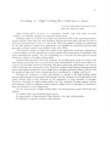Breeding for High-Yielding Rice Cultivars in Japan
Tropical agriculture research series : proceedings of a symposium on tropical agriculture researches
| ISSN | 03889386 |
|---|---|
| 書誌レコードID(総合目録DB) | AA00870529 |

本文フルテキスト
tars21-_277-277.pdf167.74 KB
High-yielding ability involves two components, namely, high yield under favorable conditions and stability against environmental disturbances.
Breeding based on scientific knowledge was initiated in 1903 in the agricultural experimental stations. Since then, the main breeding objective has been high yield and the level of yield has increased from 2 t/ha to 5 t/ha. In the 1950's the pedigree method was substituted for the bulk method in which early generations were handled as populations and the rapid generation advance method was adopted in the early 1960's.
The simplest strategy for high yield consists of the application of nitrogen, enhancement of photosynthetic activity, and increase of grain number and accumulation of assimilates. But many inconsistencies persist. The role of breeding is to overcome the discrepancies among characters related to the high-yielding ability.
Semidwarfism has been one of the solutions. An excellent gene on the sd-1 locus of the third linkage group must have occurred many times independently in all the areas where rice is grown and has been utilized for breeding. This gene reduces the culm length to 10 to 20 cm without affecting other agronomic traits. Therefore, lodging which hampers ripening and also affects harvesting becomes less severe under heavy nitrogen application. Many cultivars with
the semidwarf gene have been released and have contributed to a higher yield level.
Breeding for resistance to pests and diseases is related to the high-yielding ability because high nitrogen level promotes the damage. Sterility caused by cool temperature at the pollen meiosis stage is also enhanced by the application of large amounts of nitrogen. Therefore, breeding for high-yielding ability has also included breeding against adverse environments. Cultivars released recently possess a higher level of resistance or tolerance to pests and diseases or cool temperature.
For the future pursuit of high-yielding ability, the following three points will be the main subjects.
(1) a better plant type including larger grains,
(2) improvement of physiological traits related to the high-yielding ability,
{3) utilization of genetic resources and heterosis.
Breeding based on scientific knowledge was initiated in 1903 in the agricultural experimental stations. Since then, the main breeding objective has been high yield and the level of yield has increased from 2 t/ha to 5 t/ha. In the 1950's the pedigree method was substituted for the bulk method in which early generations were handled as populations and the rapid generation advance method was adopted in the early 1960's.
The simplest strategy for high yield consists of the application of nitrogen, enhancement of photosynthetic activity, and increase of grain number and accumulation of assimilates. But many inconsistencies persist. The role of breeding is to overcome the discrepancies among characters related to the high-yielding ability.
Semidwarfism has been one of the solutions. An excellent gene on the sd-1 locus of the third linkage group must have occurred many times independently in all the areas where rice is grown and has been utilized for breeding. This gene reduces the culm length to 10 to 20 cm without affecting other agronomic traits. Therefore, lodging which hampers ripening and also affects harvesting becomes less severe under heavy nitrogen application. Many cultivars with
the semidwarf gene have been released and have contributed to a higher yield level.
Breeding for resistance to pests and diseases is related to the high-yielding ability because high nitrogen level promotes the damage. Sterility caused by cool temperature at the pollen meiosis stage is also enhanced by the application of large amounts of nitrogen. Therefore, breeding for high-yielding ability has also included breeding against adverse environments. Cultivars released recently possess a higher level of resistance or tolerance to pests and diseases or cool temperature.
For the future pursuit of high-yielding ability, the following three points will be the main subjects.
(1) a better plant type including larger grains,
(2) improvement of physiological traits related to the high-yielding ability,
{3) utilization of genetic resources and heterosis.
| 刊行年月日 | |
|---|---|
| 作成者 | Kiyoaki MARUYAMA |
| 公開者 | Japan International Research Center for Agricultural Sciences |
| 巻 | 21 |
| 開始ページ | 277 |
| 終了ページ | 277 |
| 言語 | eng |
